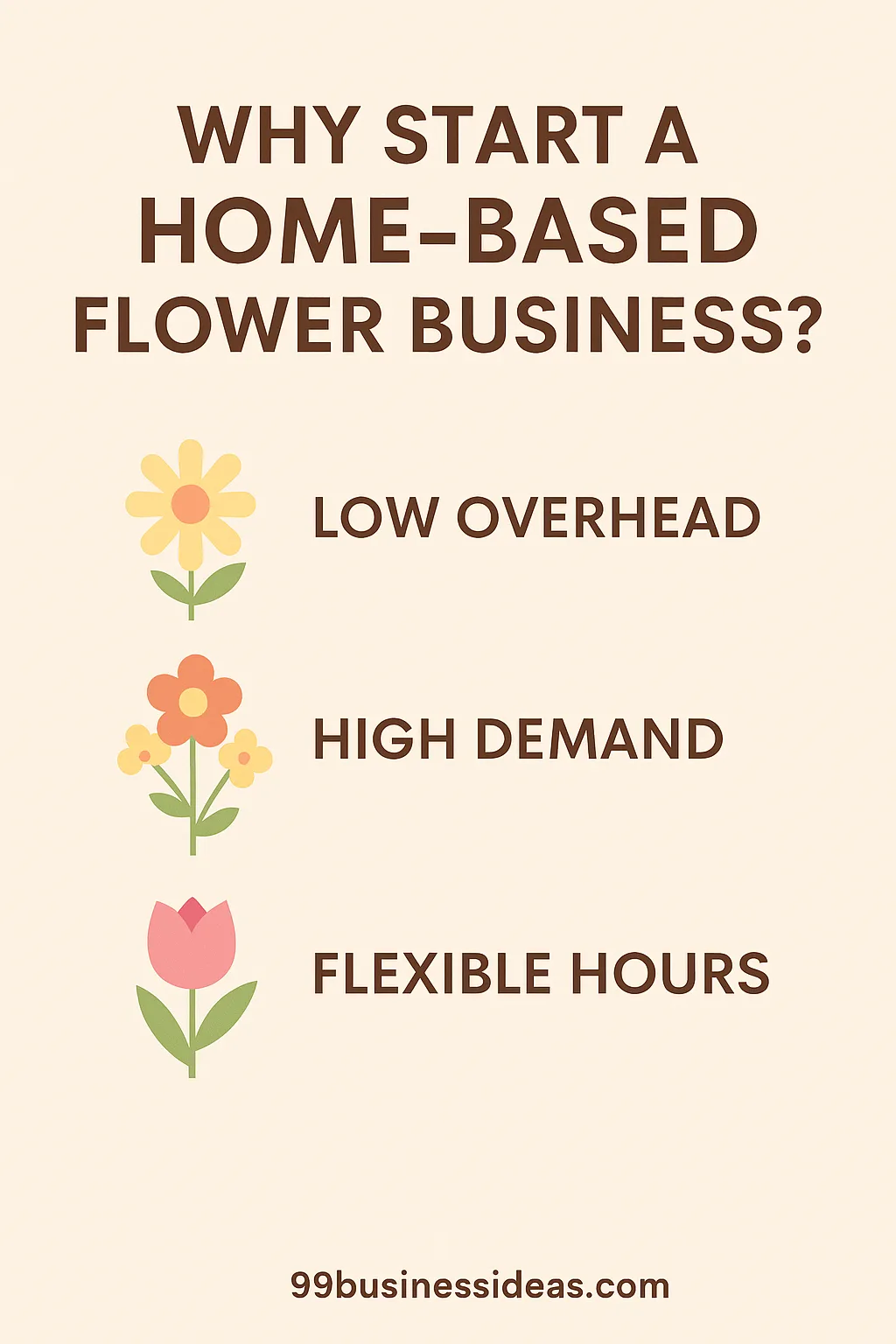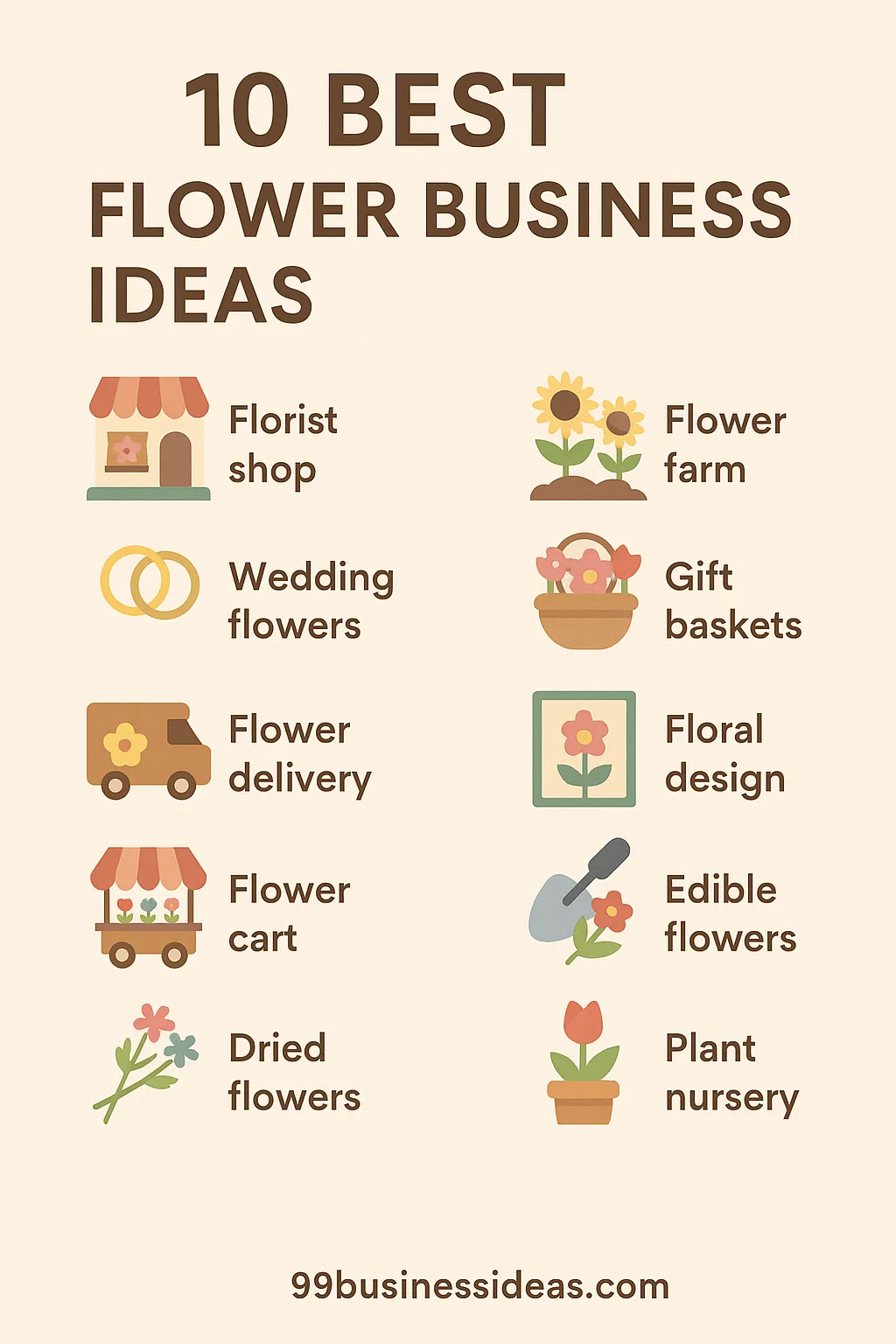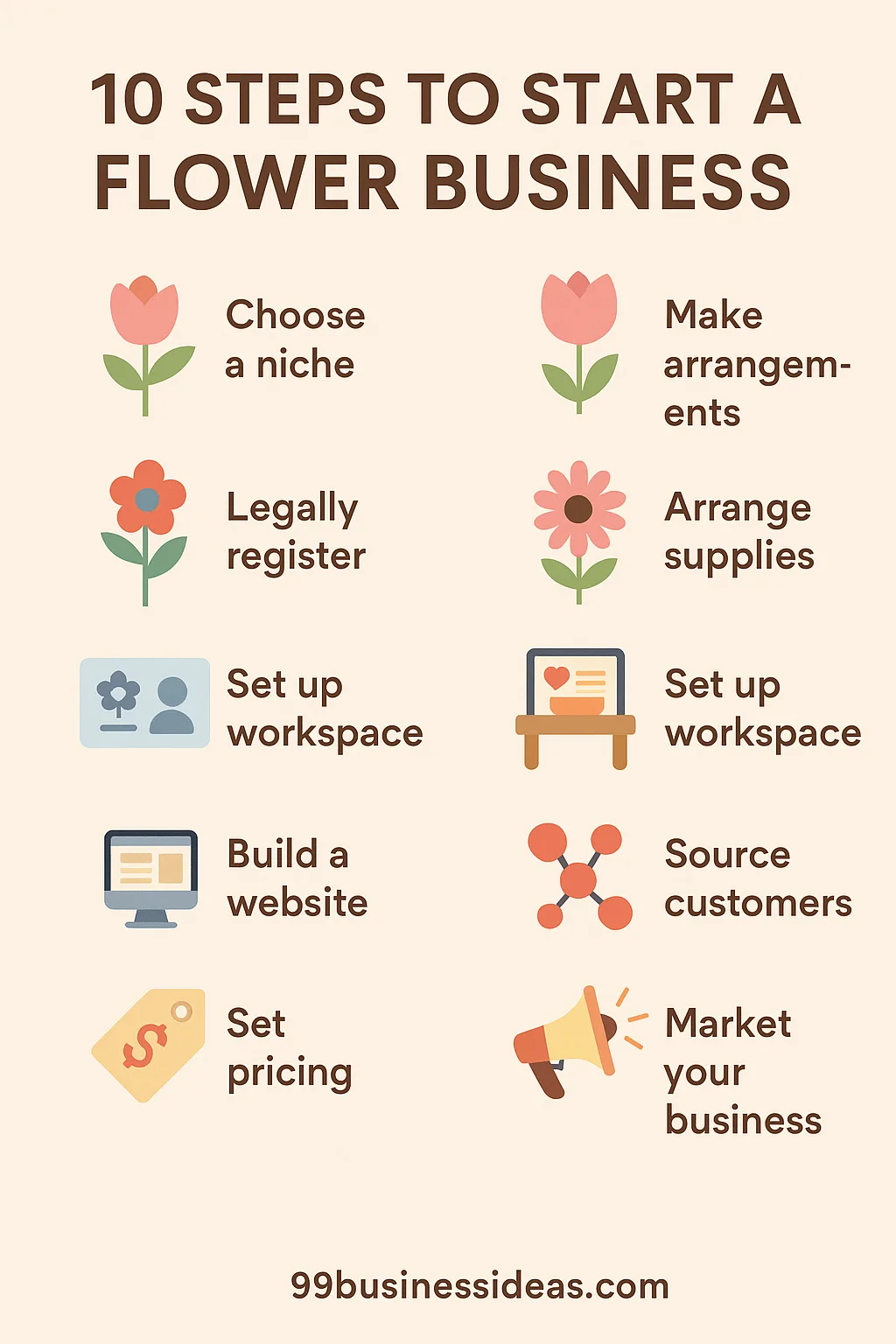How To Start a Profitable Flower Business from Home – Complete Guide
If you love flowers and dream of running your own business, starting a flower business from home could be the perfect idea. It’s a business that lets you work creatively, connect with people, and bring beauty into the world — all without needing a huge investment. Today, more people are choosing fresh flowers for celebrations, gifts, home décor, and even online subscriptions.
In this guide, I’ll walk you through everything you need to know about starting a home-based flower business.
Let’s dive in!
Why Launch a Flower Business at Home?

Below are some fantastic reasons why starting a flower business at home is a great idea:
- Minimum initial investment relative to opening an entire retail flower shop.
- Comfy working schedules — ideal when you have family or other commitments.
- Increasing customer interest in domestic, handmade, and bespoke floral arrangements.
- Marketplace opportunities for selling flowers worldwide online through e-commerce and social networking sites.
You can make a profitable business from doing something you love.
Flower Business Ideas To Begin At Home

First, determine what kind of flower business you wish to begin.
Some ideas include:
- Sales of bouquets and arrangement orders for birthdays, weddings, and anniversaries.
- Floral services for events (weddings, corporate events, parties).
- Flower box subscription (weekly or monthly shipment).
- Preserved flowers and dried flowers in arrangements.
- Do-it-yourself flower kits that clients can use to arrange their own bouquets.
- An online flower shop that delivers fresh flowers locally or ships dried flowers around the world.
- Home garden flower sales, if you prefer to grow and sell your own flowers.
Both methods have their own look and client base. You can begin with one and add more later.
Read: Best Flower Business Ideas
How Large is the Flower Business Opportunity Worldwide?
The world flower market is flourishing. Here are a few quick statistics:
- The global floriculture industry was valued at USD 55.2 billion in 2023 and is projected to grow at a CAGR of over 5.1% from 2024 to 2032
- The industry is projected to expand 5% annually over the next five years.
- Flower sales online are a huge trend, particularly following the pandemic.
- There is high demand in the U.S., Europe, Asia, and even Africa and Latin America.
Individuals are purchasing flowers not only for holidays and formal events but for decorating homes, health and wellness, and as gifts — a trend that is opening up opportunities for year-round flower businesses.
Step-by-Step Guide: How to Start a Flower Business from Home

1. Research Your Market
Before you buy your first bunch of roses, do a little homework:
- Who are your potential customers? (Locals? Online shoppers? Event planners?)
- What types of flowers and services are popular in your area?
- Who are your competitors? How can you offer something unique?
You can research online, visit local markets, or even talk to potential customers.
Tip: Focus on a specific niche like wedding flowers, eco-friendly bouquets, or subscription services to stand out.
2. Create a Business Plan
A simple business plan helps you stay organized.
It should cover:
- Business goals: What do you want to achieve in 6 months, 1 year?
- Target market: Who will you sell to?
- Products and services: Fresh flowers, subscriptions, event decoration?
- Pricing strategy: How much will you charge?
- Marketing plan: How will you promote your business?
- Financial plan: Budget for setup and expected earnings.
Even a basic plan gives you clarity and direction.
3. Get the Right Licenses and Permits
Depending on where you live, you might need:
- A basic business license.
- Home occupation permits (to run a business from home).
- Sales tax registration (for selling goods).
Check your local city or country regulations. Starting legally helps you build trust with customers and grow your brand.
4. Set Up Your Workspace
You don’t need much to start, but a clean workspace is essential. Use a spare room, garage, or even a large table.
You don’t need a huge area, but you’ll need:
- A cool, clean space to store flowers.
- Worktables for arranging bouquets.
- Storage shelves for vases, floral foam, ribbons, and wrapping papers.
- Buckets and containers to keep flowers fresh.
If you plan to grow your own flowers, a small backyard or greenhouse could be enough to start.
5. Source Your Flowers and Supplies
There are several options:
- Local flower farms.
- Wholesale flower markets.
- Flower auctions (popular in Europe and Asia).
- Importers (for rare and exotic flowers).
Always buy fresh, high-quality flowers. Good suppliers mean happy customers.
Other supplies you’ll need:
- Floral wire and tape.
- Scissors and cutters.
- Wrapping paper and ribbons.
- Vases, baskets, and boxes.
In addition, consider buying a small fridge. It will help keep flowers fresh.
6. Build Your Brand
Your brand is more than just your logo — it’s how people feel about your business.
Decide:
- Business name: Choose a name that is memorable and meaningful.
- Logo and Colors: Create a simple, attractive logo.
- Website: Build a basic website or online store to showcase your flowers.
- Social media pages: Set up Instagram, Facebook, and Pinterest accounts.
Professional branding helps you look credible, even if you’re just starting from your living room.
7. Set Your Prices
Pricing flowers can be tricky, but a simple formula can help:
- Add up the cost of flowers, supplies, and labor.
- Add a markup for profit (usually 2–3 times your costs).
- Research your local market rates to stay competitive.
Offer different price points. It can be from simple $20 bouquets to premium $150 wedding centrepieces to attract different customers.
8. Start Marketing Your Flower Business
Here are some powerful ways to promote your new flower business:
- Post beautiful photos on Instagram and Pinterest.
- Create Facebook ads targeted to local customers.
- Collaborate with event planners, wedding venues, and photographers.
- Offer special deals for holidays like Valentine’s Day, Mother’s Day, and Christmas.
- Set up a booth at farmer’s markets or local festivals.
- Encourage customer reviews and testimonials online.
Consistency is the key. Show up regularly and let people know you’re open for business!
9. Manage Deliveries and Logistics
If you plan to deliver flowers:
- Decide if you’ll do it yourself or hire help.
- Use eco-friendly packaging whenever possible.
- Offer same-day or next-day delivery in your area.
For international sales (dried flowers, for example), partner with reliable shipping services like DHL, FedEx, or UPS.
10. Grow and Expand
Once you’re steady, think about scaling:
- Add new products like potted plants, DIY kits, or workshops.
- Offer flower subscriptions for regular income.
- Collaborate with hotels, offices, and restaurants to provide regular floral displays.
You can also grow your own flowers or set up a bigger studio when you’re ready.
How Much Does It Cost to Start a Flower Business from Home?
Here’s a rough breakdown:
| Item | Estimated Cost |
| Flowers and supplies (initial stock) | $300–$700 |
| Tools and work tables | $200–$500 |
| Website and marketing | $100–$300 |
| Permits and licenses | $50–$200 |
| Packaging and branding | $150–$400 |
| Total Estimated Startup Cost | $800–$2,000 |
Note: (Costs may vary based on location and scale.)
Starting small is okay. Many successful florists started with just a few hundred dollars.
How Much Can You Earn?
Earnings depend on your location, pricing, and marketing. Here’s a basic example:
- If you sell 100 bouquets a month at $40 each = $4,000/month revenue.
- After costs, you could profit around $2,000–$3,000/month.
Special event work (like weddings) can bring even higher profits — some wedding floral contracts can range from $500 to $5,000 or more! Over time, as your brand grows, your income can increase significantly.
Common Challenges of Floral Business and How to Overcome Them
- Flower spoilage: Always manage inventory carefully to avoid waste.
- Seasonal demand: Offer add-ons like potted plants or dried flowers during slow seasons.
- Competition: Find a niche or signature style that makes you different.
- Delivery issues: Invest in reliable delivery options or work with couriers.
Every business has challenges — what matters is finding solutions and staying committed.
Pro Tips for a Successful Home Flower Business
- Take beautiful photos — customers buy with their eyes first!
- Offer excellent customer service — a happy customer is your best advertisement.
- Stay updated with flower trends — like pastel bouquets, native plants, or minimalist designs.
- Attend floral design workshops or online courses to improve your skills.
- Network with local businesses — partnerships can lead to big orders.
Frequently Asked Questions (FAQs)
Do I need a license to sell flowers from home?
Yes, in most locations, you need a business license to operate legally. You may also need a sales tax permit and a home occupation permit, depending on your city or state. Always check your local regulations before starting.
How much money do I need to start a home-based flower business?
Starting costs can range from $500 to $2,500, depending on your setup. Expenses include flowers, basic tools (scissors, pruners, vases), a simple workspace, and branding materials like business cards and a website.
Can I run a flower business part-time?
Yes. Many people start by selling flowers on weekends or during holidays. A home-based flower business offers flexibility, so you can scale it up or down depending on your schedule.
Where should I source flowers for my business?
You can buy flowers from local flower farms, wholesale flower markets, or online suppliers like FiftyFlowers and BloomsByTheBox. Sourcing locally often gives fresher products and supports your community.
How do I price my flower arrangements?
A good rule of thumb is to charge 3 to 5 times the cost of your flowers and materials. Don’t forget to factor in your time, delivery costs, and overhead expenses to ensure a healthy profit margin.
Can I sell flowers online only?
Yes! Many home florists sell bouquets through Instagram, Facebook Marketplace, Etsy, or their own websites. Offering local delivery or pickup options can help you grow quickly.
What types of flowers sell best?
Roses, lilies, sunflowers, and tulips are always popular. However, seasonal flowers and unique arrangements (like dried flowers or native plants) are trending and can help you stand out.
How do I handle deliveries?
You can start by delivering orders yourself if the distance is manageable. As you grow, consider partnering with local courier services or apps like Roadie for larger areas.
Is it profitable to sell dried flowers?
Yes! Dried and preserved flowers have become a high-margin, low-maintenance niche. They have a longer shelf life and are perfect for gifts, home décor, and weddings.
How can I market my flower business on a small budget?
Use free or low-cost marketing strategies like social media (Instagram, Pinterest), word of mouth, local SEO (Google My Business), and collaborations with local businesses or wedding vendors.
Final Thoughts
Flower business from home isn’t only a means to earn money — it’s a means to bring happiness, beauty, and positive relationships. With planning, passion, and a little bit of imagination, you can develop a brand that blossoms and flourishes year by year.
No matter whether you aspire to own a small town florist flower delivery company or be an international online flower company, the opportunity exists — and it awaits you.
So, what do you have to lose? Your flower business adventure begins today!🌸🌻🌷

Editorial Team at 99BusinessIdeas is a team of experts led by Rupak Chakrabarty with over 25 years of experience in starting and running small businesses. Started in 2010, 99BusinessIdeas is now one of the largest free small business resources in the industry.